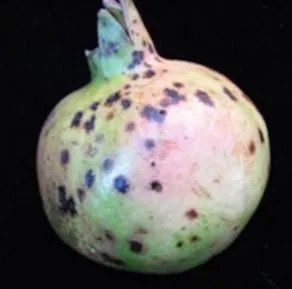Pomegranate
Pomegranate is a medium-sized shrub/tree, produces edible fruits, thrives in full sun, and is widely used medicinally.

Habit
Shrub
Height
3 to 5 m
Growth
Medium
Soil
Well-drained, Sandy Loam
Shade
Full Sun
Moisture
Moderate
Edible
Yes
Medicinal
Yes
Origin
Middle East, Asia
Climatic Condition
Tropical, Subtropical
Temperature (°)
20°C to 30°C
Humidity (%)
50% to 60%
Potting media
50% Loam, 40% Sand, 10% Organic Matter
Fertilizers
Organic Fertilizer
Watering
Regular watering
Plant Weight
5 to 10 kg
Flowering Time
Summer to Fall
Soil Ph level
6.0 to 7.0
Water Ph level
6.0 to 7.5
Soil EC
0.6 to 1.0 mS/cm
Yield Per Plant
12 to 15kg per tree
NPK ratio
10:10:10
life Span
10 to 30 years
Health Benefits
High in Antioxidants, Medicinal
Suggested Grow Media or Potting Mix ?
40% loam, 30% sand, 30% compost
Suggested Fertigation/Fertilizers
Apply monthly with liquid organic fertilizer
Common Diseases and Remedies
Alternaria leaf spot , cercospora leaf spot , Anthracnose .
Fruit shows small irregular black colour spots , small reddish brown circular spots
sowing seeds on raised beds upto 6-8 cm height , pruning
HEALTH BENEFITS
· Rich in antioxidants that protect against heart disease.
· Supports digestive health and prevents inflammation.
· Boosts immunity and promotes healthy skin.
What Is An Pomegranate Tree?
A pomegranate is a fruit from the Punica genus, known for its round shape, tough skin, and seed-filled interior. Rich in antioxidants and vitamins, pomegranates are consumed fresh, juiced, or used in cooking with various health benefits and a long history of cultivation.

What Are The Different Pomegranate Plants ?
1. Wonderful
Desirable and widely grown, it features large, red fruit with sweet and tangy arils.
2. Haku Botan
From Japan, it has large, pink to reddish fruit with sweet, mild seeds.
3. Ambrosia
Soft seeds with a sweet taste, pink to red in colour with tender arils.
4. Granada
Produces large, dark red fruits with a sweet, slightly tart flavour, often juiced.
5. Salavatski
Russian with dark red fruit known for cold tolerance.

How to care for Pomegranate Plants ?
1. Location
Pomegranate trees prefer to be grown outdoors in full sunlight and well-drained soil, but can also be grown indoors or on a patio in containers with the proper care.
2. Sunshine
Pomegranates need plenty of sunshine, around 6 to 8 hours of direct sunlight each day. When cultivating indoors, position the container close to a south-facing window or utilize extra grow lights for sufficient light exposure.
3. Soil
Pomegranate can be grown on a wide range of soils. It grows well in medium deep, loamy and well-drained soils having a pH of 7.5. Heavy soils with poor drainage facilities are unsuitable for its cultivation. the fruit colour development, quality and increases pest and disease attack.
4. Hydration
Water the pomegranate plant once the top layer of soil has dried out. Make sure to let any extra water drain out to avoid waterlogging.

5. Nourishment
Feed your pomegranate tree a balanced fertilizer with ratios like 10-10-10 or 14-14-14 for a mix of essential nutrients. Add zinc and iron if your soil is deficient, using fertilizers or soil amendments with these micronutrients.
6. Issue
Aphids, small insects infesting pomegranate trees, can be controlled with insecticidal soaps or neem oil. Powdery Mildew, a common fungal disease on leaves, can be treated with fungicidal sprays or sulphur treatments. Nutrient deficiencies in pomegranate trees can be identified through a soil test and treated with appropriate fertilization. Frost damage can harm flowers and young fruit, so providing frost protection is crucial. Improper pruning can lead to issues like poor air circulation and reduced sunlight penetration, while regular, proper pruning helps maintain a healthy tree.
What are the Benefits of Pomegranate Tree ?
Pomegranates are rich in antioxidants, mainly polyphenols, which aid in combating oxidative stress and may enhance overall health while decreasing the likelihood of chronic diseases. Additionally, pomegranates possess antibacterial and antiviral properties that could assist in fighting against specific infections.

FAQs About Growing Pomegranate
1. How do I go about planting a pomegranate tree?
Choose a sunny spot with well-drained soil, plant at the same depth as the nursery container, and space adequately.
2. When and how should I water my pomegranate tree?
Water deeply, especially in dry spells, and let the soil dry out between waterings to avoid waterlogging.
3. When is the best time to harvest pomegranates?
Harvest when the skin is firm and colour is vivid, cutting the fruit off the tree.
4. Can I grow pomegranates in containers?
Yes, grow in a large container with good drainage and plenty of sunlight.
5. How can I protect pomegranate trees from frost?
Shield young trees with blankets or burlap in freezing weather to guard against.

